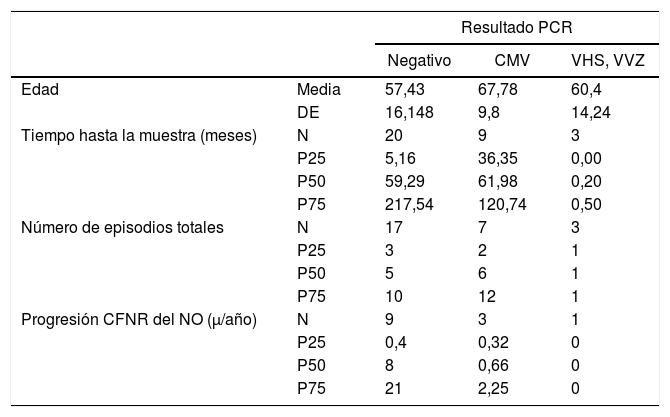Analizar los datos clínicos de pacientes con uveítis anteriores agudas hipertensivas HLA-B27 negativas. Se obtuvieron muestras de humor acuoso, en las que se realizó reacción en cadena de la polimerasa (PCR), y se clasificaron los pacientes en 3 grupos según las muestras fueran positivas para citomegalovirus (CMV), virus herpes (VHS-VVZ) o negativas para ambos.
Material y métodosEn los 3 grupos de pacientes se recogieron las variables edad, sexo, agudeza visual, presión intraocular (PIO), células en cámara anterior, precipitados retroqueráticos, tratamiento hipotensor, cirugía de glaucoma, retina o trasplante corneal y grosor central de la capa de fibras nerviosas de la retina. Todas las variables fueron recogidas en la visita basal y a los 3, 6 y 12 meses.
ResultadosSe incluyeron 36 pacientes, con una edad media de 59,78±15,26 años. El valor medio basal de PIO fue 40±10,42mmHg en el grupo CMV frente a 23,8±10,4mmHg en el VHS-VVZ y 22,65±9,9mmHg en el grupo PCR negativo. La frecuencia basal de precipitados retroqueráticos, tratamiento hipotensor, cirugía de glaucoma y trasplante corneal fue mayor en los positivos para CMV. Sin embargo, al año la pérdida de capa de fibras nerviosas de la retina y la tasa de cirugía de glaucoma fue mayor en el grupo PCR negativo. Durante el seguimiento, en los 3 grupos hubo correlación directa y positiva entre la PIO y la inflamación en cámara anterior. Esta correlación fue de 0,94 (p=0,05) para el positivo para CMV, de 0,24 (p=0,75) en el de VHS-VVZ y de 0,98 (p=0,17) en el negativo.
ConclusionesLas uveítis anteriores agudas hipertensivas HLA-B27 negativas con PCR de humor acuoso positiva para CMV tienen una presentación más agresiva inicialmente; sin embargo, al año de seguimiento el daño glaucomatoso es menor que en aquellas con PCR negativa. En las uveítis anteriores agudas hipertensivas, cuando, con el tratamiento oportuno, se controla la inflamación en cámara anterior, se controla la PIO.
To perform a retrospective analysis on patients with HLA-B27 negative hypertensive acute anterior uveitis. Aqueous humor samples were obtained on which a polymerase chain reaction (PCR) test was performed. The patients were then classified into 3 groups depending on whether they were positive for cytomegalovirus (CMV) or herpesvirus (HSV-VZV) or negative for both.
Material and methodsDifferent variables were collected in successive visits (baseline, 3, 6, and 12 months). The variables were age, sex, visual acuity, intraocular pressure (IOP), cells in the anterior chamber, retro-keratic precipitates, hypotensive treatment, glaucoma or retina surgery, corneal transplantation, and central thickness of the retinal nerve fiber layer.
ResultsThe sample was 36 patients, with a mean age of 59.78±15.26 years. The mean baseline IOP value was 40±10.42mmHg in the CMV group compared to 23.8±10.4mmHg in the HSV-VZV, and 22.65±9.9mmHg in the negative group. The baseline frequency of retro-keratic precipitates, hypotensive treatment, glaucoma surgery, and corneal transplantation was higher in CMV positives. At one year, the loss of retinal nerve fiber layer and glaucoma surgery was greater in the negative group. In the 3 groups, there was a direct and positive correlation between IOP and inflammation in the anterior chamber. Being 0.94 (P=.05) for the positive for CMV, 0.24 (P=.75) in that of HSV-VZV, and 0.98 (P=.17) in the negative group.
ConclusionsHLA-B27 negative hypertensive acute anterior uveitis with CMV positive has a more aggressive initial presentation. However, after one year, the glaucomatous damage is less than in the negative group. In hypertensive acute anterior uveitis, when inflammation in anterior chamber is controlled then IOP is also controlled.
Artículo
Comprando el artículo el PDF del mismo podrá ser descargado
Precio 19,34 €
Comprar ahora











